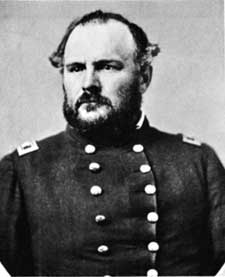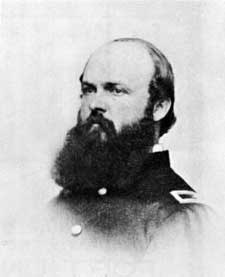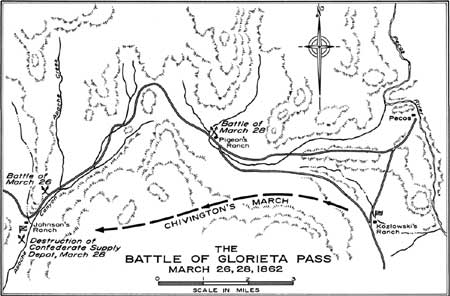|
FORT UNION National Monument |
 |
 Maj. John M. Chivington, 1st Colorado Volunteers, played the decisive part in defeating the Confederates at Glorieta Pass. State Historical Society of Colorado. |
 Col. John P. Slough, 1st Colorado Volunteers, commanded Union forces at the Battle of Glorieta Pass. State Historical Society of Colorado. |
The Battle of Glorieta Pass
On March 25 Colonel Slough ordered Maj. John M. Chivington and 400 men, part infantry and part cavalry, to conduct a reconnaissance in force toward Santa Fe. Next morning, as Chivington descended the western slope of Glorieta Pass into Apache Canyon, he ran into Major Pyron's Confederates, four dismounted companies of the 5th Texas, entering the western end of the canyon. Pyron planted his two mountain howitzers on the Santa Fe Trail and opened fire. By sending flanking detachments to the slopes on either side of the canyon, Chivington twice forced the enemy artillery to pull back. As the guns were unlimbering the second time, he sent his cavalry charging down the road. The bridge across Apache Creek had been destroyed, but the horsemen jumped the ditch and piled into the disorganized Texans. The charge broke Confederate resistance and scattered the Texans to the rear. As night was approaching, Chivington assembled his command and returned to Pigeon's Ranch, just east of the summit of Glorieta Pass.
Major Pyron set up camp at Johnson's Ranch, outside the canyon, and sent a messenger to Colonel Scurry at Galisteo asking for help. Scurry's men made a forced march and reached Johnson's Ranch at about 3 a.m. on March 27. They parked the 80 supply wagons and, expecting a Federal attack, organized a defense perimeter. Scurry waited all day, then on the morning of the 28th decided to take the offensive. Leaving a guard with his supply wagons at the ranch, he entered Apache Canyon with about 700 men.

(click image for an enlargement in a new window)
Slough had also decided to take the offensive, and with 900 men and the artillery he advanced toward the summit of the pass. The other 400 he had sent with Major Chivington to slip around the Confederates and strike them in the rear. Slough and Scurry collided at Pigeon's Ranch at 10:30 a.m. The Federals set up a defensive line. Scurry mounted repeated assaults, first on one flank, then on the other, next on the center, and finally on all fronts at once. Twice the Federal line fell back to new positions. By late afternoon both sides were exhausted.
Meanwhile, Major Chivington had left the road and led his men into the timbered mountains south of the pass. At 1:30 p.m. he emerged on the brow of a steep bluff. Below was Johnson's Ranch and the Confederate wagon park. His troops poured down the bluffs and quickly took possession of the supply depot. A cannon opened fire, but sharpshooters silenced it by picking off the gunners. The Federals burned the 80 wagons, containing ammunition, food, clothing, and forage; slaughtered 30 horses and mules found in a corral; spiked the field piece; and withdrew with 17 prisoners.
Scurry had all but won the battle at Pigeon's Ranch when a courier galloped up with word of the disaster that had befallen his supply base. He sent a flag of truce to Slough asking for a cease-fire, which was gladly granted. The Union troops retired to Kozlowski's Ranch, while the Confederates remained on the field through the following day.
Confederate casualties were 36 killed, about 60 wounded, and 25 taken prisoners. Colonel Slough reported losses of 29 killed, 64 wounded, and 13 prisoners, although other Union participants gave higher figures. Considering the total number involved in the battle, it had been a bloody affair.
Loss of the supply train dashed Sibley's hopes and in the end destroyed his grand design for the Confederacy in the West. Sibley withdrew to Albuquerque and, harassed by Canby, began a desperate retreat through rugged, waterless mountains to his base at Fort Bliss. Baylor's Territory of Arizona also collapsed. Ultimately even Fort Bliss was abandoned. As one of the Texans wrote to his wife, "If it had not been for those devils from Pike's Peak this country would have been ours."

|
|
Last Modified: Sat, Sep 28 2002 10:00:00 pm PDT |


